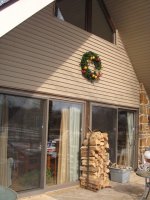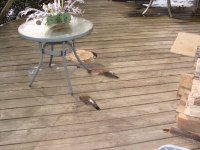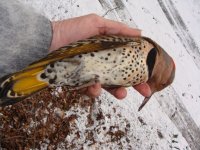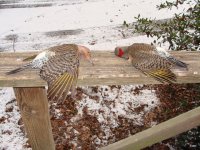Elk River Rancher
Casual Birder
Just reviewed Ashley Boelens' comments about the waxwing window strike, and thought I'd share a similar story and photos ...
Some mornings are happier than others ... and some mornings bring mourning. My home is (well, was ...) a full glass front "A"-frame. Sad to say, it's not appropriate in many ways - either to its geographic location (eastern shore of the northernmost reaches of the Chesapeake Bay, Maryland, USA - the perfect place for a nice low-roofed ranch. A-frames are designed for a 'snow load' - the house would be ideal in the Poconos, or the Green Mountains - but on the Eastern Shore .... not so much.) or to its lot location (25+ acres to work with, and yet the builder/original owner faced it not due south, for the eco advantage of sunshine warmth; nor to the woodlands, for the view; but to the access road - which means, with 10 homes 'behind' it, the full glass front meant no privacy, whatsoever!). I bought this place because a raccoon I rescued from orphan status needed a 'soft release' situation - which is a long story in itself - but I digress.
With a full glass front, there were - and still are - occasions when birds collide with the glass. The trees in front of the deck are reflected in the glass, and birds will often fly into the glass, thinking they're flying into the security of the woods. I've tried 'predator silhouettes', with no appreciable change in the occasional bird collision. So, just this December, I had over 50% of the glass covered with siding. But as Burns wrote, "The best-laid schemes o' mice an 'men Gang aft agley ...".
The late morning of Jan 7, 2011, two northern flickers simultaneously flew into the sliding glass door, and both were killed. I was in the kitchen, making my afternoon meal, when I heard a loud 'thump' against the glass doors of the "great" room. I quickly went to the deck, as often, just keeping a stunned bird warm, whilst it recovers from a collision, is all that's needed to help a bird survive. Sad to say, there was no chance of helping either of these female northern flickers. In the photo of the deck, the bird on the left was still alive, when I picked it up; but bleeding from the beak, and clearly not going to survive. She was dead within a minute. The second bird was already dead.
They are such pretty birds - and I have never found one on the deck, before. The northern flicker is an ant eater, mostly, although they will eat some berries and seeds. I do put sunflower seed on the deck railing - which occasionally attracts the yellow-bellied woodpecker and the downy woodpecker to the railing - but never have I seen a flicker at the railing. It is far more common to see them on the fence posts, in the horses' paddock, particularly in the warmer months, when the honeysuckle grows. The honeysuckle tends to attract aphids, which in turn attracts ants, which in turn attracts the flicker. I do leave autumn leaf litter under the deck, as the ground feeders (the white throat sparrows and the juncos, mostly, with the occasional fox sparrow) do like to rifle (hmmm. perhaps riffle ... but no - their search is pretty vigorous - 'rifle' it is!) through the leaf debris, to find fallen seeds and insects. It's possible the flickers were likewise exploring the dirt beneath the leaf litter, looking for beetles, etc. Although there were no sentry crows calling out any 'caw, caw, caution' warning, I did scout the trees, to see if I'd spot the Cooper's Hawk. I was speculating that danger from a predator might have caused these two flickers to be sufficiently distracted in their effort to escape that they might fly into the glass; but I did not see any such predator. Also, it didn't seem likely that flickers would fly up from under the deck, to collide with the glass door. I wondered if they might have instead been in some sort of territorial dispute - how early do birds like flickers begin to look for nesting possibilities? And could such a dispute have caused these two birds to be so unaware of their surrounding that they'd fly into the glass doors? Unanswerable questions, I'm sorry to say.
I moved the carcasses of these two flickers to the fence posts, near the horses' paddock, thinking the crows might make use of them; but the horses' curiosity kicked in, and they knocked the birds off the posts. I retrieved the carcasses, and put them instead on a flat board 'platform' feeding area I often use, nearer the house. They were there for a day and night, before the crows finally noticed, and took them. So, their demise has at least provided some nutrition, for other birds. C'est la vie; c'est la mort.
Some mornings are happier than others ... and some mornings bring mourning. My home is (well, was ...) a full glass front "A"-frame. Sad to say, it's not appropriate in many ways - either to its geographic location (eastern shore of the northernmost reaches of the Chesapeake Bay, Maryland, USA - the perfect place for a nice low-roofed ranch. A-frames are designed for a 'snow load' - the house would be ideal in the Poconos, or the Green Mountains - but on the Eastern Shore .... not so much.) or to its lot location (25+ acres to work with, and yet the builder/original owner faced it not due south, for the eco advantage of sunshine warmth; nor to the woodlands, for the view; but to the access road - which means, with 10 homes 'behind' it, the full glass front meant no privacy, whatsoever!). I bought this place because a raccoon I rescued from orphan status needed a 'soft release' situation - which is a long story in itself - but I digress.
With a full glass front, there were - and still are - occasions when birds collide with the glass. The trees in front of the deck are reflected in the glass, and birds will often fly into the glass, thinking they're flying into the security of the woods. I've tried 'predator silhouettes', with no appreciable change in the occasional bird collision. So, just this December, I had over 50% of the glass covered with siding. But as Burns wrote, "The best-laid schemes o' mice an 'men Gang aft agley ...".
The late morning of Jan 7, 2011, two northern flickers simultaneously flew into the sliding glass door, and both were killed. I was in the kitchen, making my afternoon meal, when I heard a loud 'thump' against the glass doors of the "great" room. I quickly went to the deck, as often, just keeping a stunned bird warm, whilst it recovers from a collision, is all that's needed to help a bird survive. Sad to say, there was no chance of helping either of these female northern flickers. In the photo of the deck, the bird on the left was still alive, when I picked it up; but bleeding from the beak, and clearly not going to survive. She was dead within a minute. The second bird was already dead.
They are such pretty birds - and I have never found one on the deck, before. The northern flicker is an ant eater, mostly, although they will eat some berries and seeds. I do put sunflower seed on the deck railing - which occasionally attracts the yellow-bellied woodpecker and the downy woodpecker to the railing - but never have I seen a flicker at the railing. It is far more common to see them on the fence posts, in the horses' paddock, particularly in the warmer months, when the honeysuckle grows. The honeysuckle tends to attract aphids, which in turn attracts ants, which in turn attracts the flicker. I do leave autumn leaf litter under the deck, as the ground feeders (the white throat sparrows and the juncos, mostly, with the occasional fox sparrow) do like to rifle (hmmm. perhaps riffle ... but no - their search is pretty vigorous - 'rifle' it is!) through the leaf debris, to find fallen seeds and insects. It's possible the flickers were likewise exploring the dirt beneath the leaf litter, looking for beetles, etc. Although there were no sentry crows calling out any 'caw, caw, caution' warning, I did scout the trees, to see if I'd spot the Cooper's Hawk. I was speculating that danger from a predator might have caused these two flickers to be sufficiently distracted in their effort to escape that they might fly into the glass; but I did not see any such predator. Also, it didn't seem likely that flickers would fly up from under the deck, to collide with the glass door. I wondered if they might have instead been in some sort of territorial dispute - how early do birds like flickers begin to look for nesting possibilities? And could such a dispute have caused these two birds to be so unaware of their surrounding that they'd fly into the glass doors? Unanswerable questions, I'm sorry to say.
I moved the carcasses of these two flickers to the fence posts, near the horses' paddock, thinking the crows might make use of them; but the horses' curiosity kicked in, and they knocked the birds off the posts. I retrieved the carcasses, and put them instead on a flat board 'platform' feeding area I often use, nearer the house. They were there for a day and night, before the crows finally noticed, and took them. So, their demise has at least provided some nutrition, for other birds. C'est la vie; c'est la mort.







